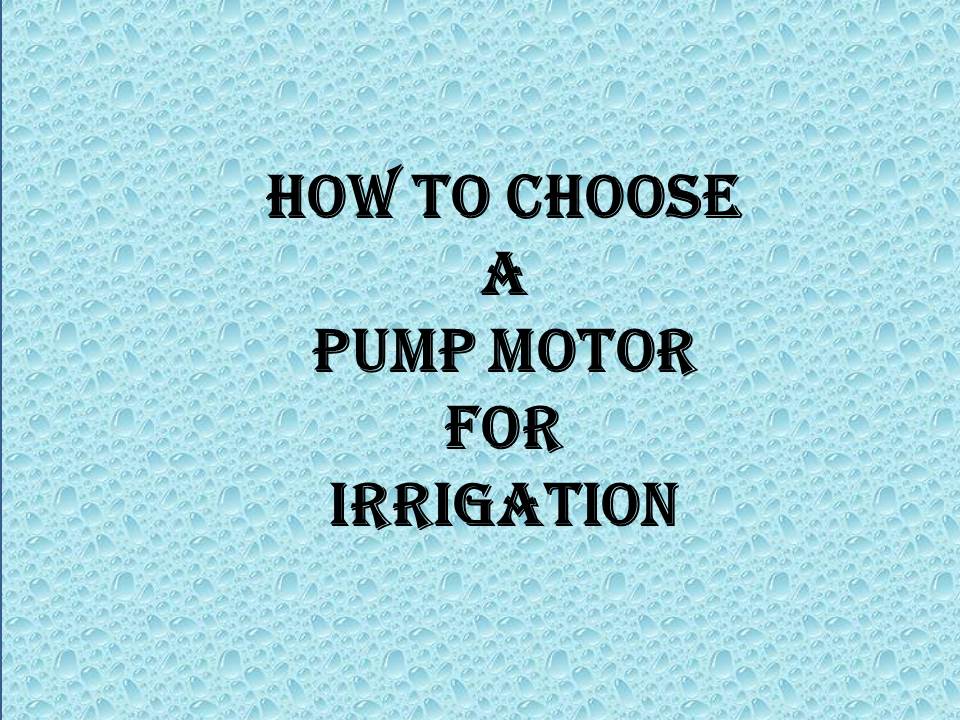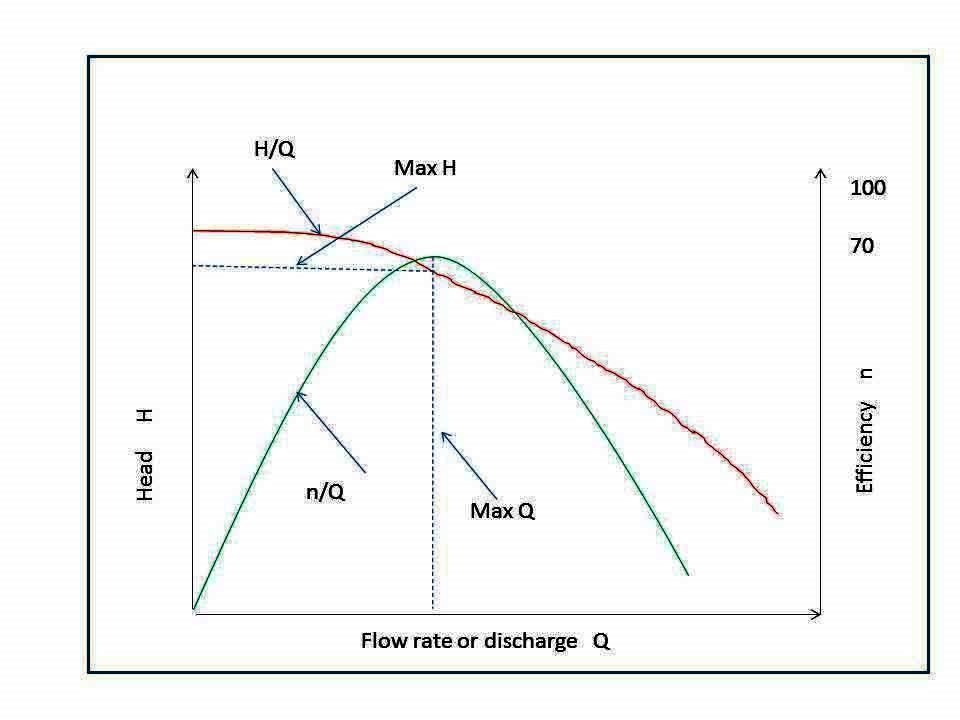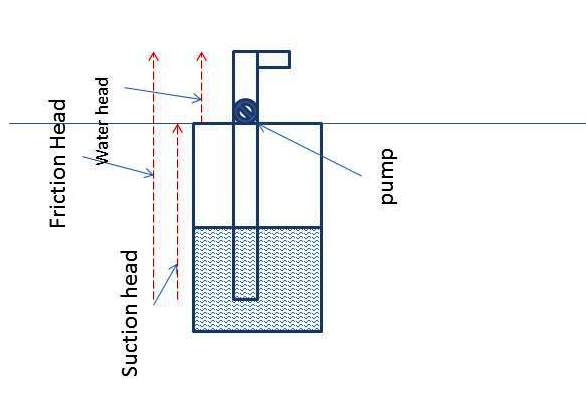How to choose a Pump Motor for Irrigation
You need a pump motor for irrigation. Yes one can go to the market and buy the best and biggest pump available and start irrigating. But remember nothing is free and cost in running operations with this pump may become too high to sustain. Also the best of market may not be best for your needs.
A pump motor consists of two parts: first is the Pump and second is the Motor. The Motor provides the energy to the Pump which will create the required water Head Pressure.
Two pump motors of same horsepower may not perform in same way in a system of irrigation. I discuss below steps to choose pump motor which will meet your requirements best.
Let us see the figure below which illustrates the text.
Any pump motor has a capability of flow of liquid measured in lpm (liter per minute) or gpm (gallons per minute). It also has the capacity to raise the water level to a height called the pressure head.
The curve in red color and denoted as H/Q is the flow rate curve of a pump motor. As can be seen if the Head is high the flow rate is lower and if the Head is low the flow is more.
The curve in green and denoted by n/Q is the efficiency of a pump motor. The efficiency n is never going to be 100% for reasons which are discussed below. Generally efficiencies around 55% are achieved. This allows for a 5 to 10 percent plus or minus efficiency to accommodate for higher pressure or higher flow rate.
We need to determine what flow rate is to be achieved at what Head pressure on the flow rate curve.
FLOW RATE
IT IS the total volume of liquid to be discharged from the various places and points in the irrigation system in a given time. It is usually measured in lpm (liters per minute) or in gpm (gallons per minute). You would need to count how many drippers, end points, sprinklers and to know their respective discharge rates. Then simply add every discharge to get the total flow rate.
In a practical application, there would be several routes of discharge. It needs to be noted that discharge cannot exceed the supply.
PRESSURE HEAD
The above diagram shows physically the various static Heads when water is to be lifted to a desired height from a given depth. In addition if drip lines or sprinklers are used their operating pressure is also to be considered.
Pumps will operate with Dynamic Head which is calculated as:
Dynamic Head = Static suction head + static elevation water head + sprinkler/drip pressure + all frictional loss heads due to pipes and fittings used.
The sprinkler/drip pressure is mostly given in psi (pressure per square inch). This should be converted to water head with the formula:
PSI = 2.31 feet head of water
General values for drip/sprinklers are:
Drip Irrigation = 70 feet head (30 PSI)
Spray Type Sprinkler Heads = 93 feet head (40 PSI)
Rotor Type Sprinkler Heads = 104 feet head (45 PSI)
Let us assume the well water is at a depth of 20 feet. The maximum height to which water is to be elevated is 10 feet. And let us assume drip irrigation so the water head for this is 70 feet. Therefore the total dynamic head = 20 + 10 + 70 = 100 feet head of water. To this frictional losses are to be added as the total length of pipe and number of bends and other fittings.
Choosing a Pump Motor
Now that we know the Flow Rate and Water Head required for the irrigation, consider the pump motor curve shown in the beginning. This curve is an illustrative one only and you need to go through manufacturer’s specifications to choose a pump which meet your requirement of flow rate and water head.
Calculations for pump motor power requirements
Earlier I have mentioned that the efficiency of a pump would not be 100%. The reason is in two terms used to calculate power requirement of a pump motor.
The first terms is Water Horsepower = (Flow Rate in gpm x Water Head in feet) / 3960
The second term is Break Horsepower = Water Horsepower / efficiency
For calculation in lpm and meters, conversion tables may be used.
General formula for the same calculation is as follows taking the specific gravity of the liquid also into consideration.
BHP = (Total Head *Flow Rate*Sp. Gravity) / (efficiency*3960)
Example: 20 drip lines each with 200 drip points each @ 2 lph at 30 psi (70 feethead of water). suction head 5 ft. Elevation Head 5 ft. Efficiency 50%.
Total Dynamic Head = 5+5 + 70+20 (friction)=100 ft
Flow = 200 x 20 x 2 lph = 8000 lph or 2000 gph or 34 gpm approximate value
Bhp = (100 x 34) /(3460 x .5) = 2 hp
A quick note please — while the lift head of a centrifugal pump is limited only by the power of the pump, the suction is limited by gravity and frictional losses in the pipe to about 22 feet !
Refer also to Drip Irrigation



Very lucidly explained, Sir. Reminds me of the time when Sri S. Srikanthan, Late Sri Ramesh Chand, Dr.Philip D’Souza, Shri Musaddi Lal, Shri M.R.S. Yadav and I were led by you at the Instrumentation-Sub Division of the Keshava Dev Malviya Institute of Petroleum Exploration, ONGC Dehradoon.
I have noticed you don’t monetize myknowledgebase.in, don’t waste your traffic, you can earn extra cash every month with new monetization method.
This is the best adsense alternative for any type of website (they
approve all sites), for more details simply search in gooogle: murgrabia’s
tools
thanks for your advice.
Can i use kilaskar 8hp disel water pump for drip irrigation
offhand one can say, yes an 8 hp diesel pump can be used. However, drip irrigation system design considers the hp of the pump last after taking into account all pressure heads, the area under drip irrigation including the number of lateral and mains.
Dear Sir,
I was struggling for info about pump selection for my farm. your explanation is simple, effective and clear.
regards
Bhaskar
glad to hear.
Dear Sir,
I was struggling for info about pump selection for my farm. your explanation is simple, effective and clear.
regards
Bhaskar